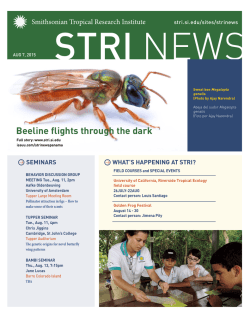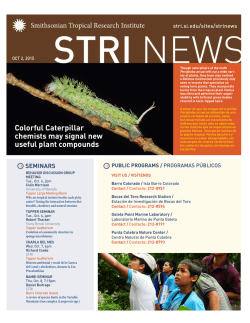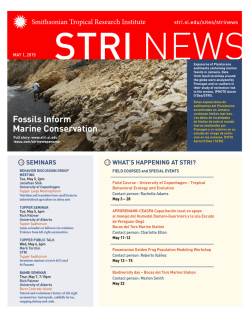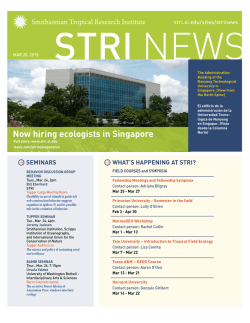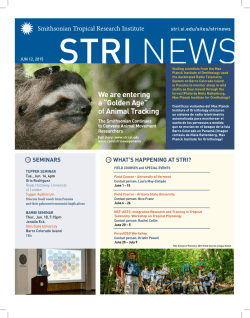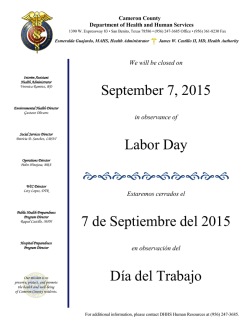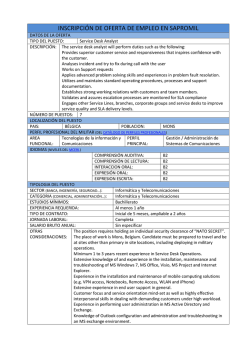
July 03, 2015
stri.si.edu/sites/strinews JUL 3, 2015 Do plant alchemists brew tropical diversity? This weevil (Curculionidae) is one of the many thousands of insects collected on Barro Colorado Island by Tupper Fellow Brian Sedio. Este gorgojo (Curculionidae) es uno de los tantos colectados en Isla Barro Colorado por Brian Sedio, becario Tupper. Full story: www.stri.si.edu issuu.com/strinewspanama SEMINARS BEHAVIOR DISCUSSION GROUP MEETING Tues., Jul. 7, 2pm Yossi Yovel Tel-Aviv University Tupper Large Meeting Room Sensory perception for foraging decision making, the bat’s point of view TUPPER SEMINAR Tues., Jul. 7, 4pm Sabrina Russo University of Nevada Tupper Auditorium TBA BAMBI SEMINAR Thur., Jul. 9, 7:15pm Phyllis Coley University of Utah Barro Colorado Island The ecology and evolution of defenses in the tree genus, Inga, and host choice by insect herbivores WHAT’S HAPPENING AT STRI? FIELD COURSES and SPECIAL EVENTS NSF-ARTS: Integrative Research and Training in Tropical Taxonomy Workshop on Tropical Phycology Contact person: Rachel Collin June 20 – July 5 ForestGEO Workshop at Gamboa Resort Contact person: Kristin Powell June 25 – July 9 Hydroids Workshop Contact person: Rachel Collin July 7 – 21 Members of ForestGEO from across the globe visited the networks original forest plot on Barro Colorado Island last weekend./ La semana pasada, miembros de ForestGeo de alrededor del mundo visitaron la primera parcela de bosque localizada en Isla Barro Colorado. THE NATIONAL AIR SERVICE VISITS GALETA On Thursday, July 2, Panama’s national Air and Naval Service visited STRI’s Galeta Point Laboratory as part of their training about environmental issues. 80 cadets between 18-28 years old learned about Galeta’s mangrove, seagrass and coral reef ecosystems. They also handled several species of echinoderms and other marine organisms in the station’s touch pools. They were extremely pleased with their visit and extended their appreciation to the staff at the station and the Smithsonian. EL SERVICIO NACIONAL AERONAVAL VISITA PUNTA GALETA El jueves 2 de julio, el Servicio Nacional Aeronaval visitó el Laboratorio de Punta Galeta como parte de la formación de sus cadetes en temas de ecología. La visita consistió de 80 jóvenes entre 18 a 28 años que luego de dividirse en varios grupos, aprendieron sobre los ecosistemas de manglares, pastos marinos y arrecifes de coral de Galeta. También interactuaron con los equinodermos y otras especies de los acuarios; al retirarse del área se mostraron sumamente complacidos, por toda la información y los nuevos conocimientos adquiridos y extendieron su agradecimiento al personal del Laboratorio y al Smithsonian. ARRIVALS Andres Vega University of California – Northridge Aislamiento genético y de comportamiento de la rana arborea de ojos rojos Gamboa Allison Davis University of Colorado Demography and Intergroup Relationships in Cebus capucinus Barro Colorado Island Holly Cronin McGill University Historical and Institutional Analysis of Panama’s Seaweed Industry Naos Marine Lab, Galeta Station, Gamboa, Bocas Del Toro and Tupper Alan Ward University of Oxford Seed predation by insects in tropical forests: a quantitative food web approach Barro Colorado Island Scott Collins Butler University Underwater light and visual ecology of marine fishes isolated by the Isthmus of Panama DEPARTURES Sean Mattson To Bocas Del Toro For dive training and frog research Carmen Schloeder To Maryland, USA To attend the BioVision workshop at the Smithsonian Environmental Research Center Panama [email protected] Phyllis Coley, Thomas Kursar and Gabrielle Ghabash University of Utah Defenses of young plants against herbivores and pathogens Barro Colorado Island Diana Hsueh and Wade McGillis Columbia University Ana Palacio University of Miami Peggy Fong University of California - Los Angeles Viktor Brandtneris University of the Virgin Islands Are Eastern Tropical Pacific reefs becoming more resilient to ENSO? Panama Emily Weiss Oregon State University Hazel Berrios Arkansas University Evolution and ecology of a model sea anemone mutualism in Pacific and Caribbean mangroves of Panama Naos Marine Lab, Galeta Station, Bocas Del Toro and Tupper Yui Matsumoto and Maria Miglietta Texas A&M University Magdalena Alpízar and Carolina Sheridan Universidad de Costa Rica Luis Martell and Stefano Piraino Università del Salento Pooja Nagale Bombay Natural History Society Sornsiri Phongphattarawat Chulalongkorn University Alena Sukhoputova Moscow State University Andrea Moncada Universidad Central de Venezuela Sarai Jeronimo Universidad Nacional Autónoma de México Jonathan Lawley Universidade Federal de Santa Catarina Davide Maggioni Università degli Studi di Milano Bicocca NSF-ARTS research and training in the systematics of Hydrozoa (Cnidaria) Bocas Del Toro @stri_panama #smithsonian PUBLICATIONS Bouchard, S. C., O’Leary, C. R. Jenney, Wargelin, L. J., Charbonnier, J.F. and Warkentin, K. M. 2015. Post-metamorphic carryover effects of larval digestive plasticity. Functional Ecology, doi:10.1111/13652435.12501 Cadena, E. and Jaramillo, C. A. 2015. The first fossil skull of Chelus (Pleurodira: Chelidae; Matamata genus turtles) from the middle Miocene of Colombia. Palaeontologia Electronica, 18.2.32A: 1-10. Nerea Nieto To Bocas Del Toro For BRS communications and TTT course support Gross, A., Turner, B. L., Wright, S. J., Tanner, E. V. J., Reichstein, M., Weiner, T. and Angert, A. 2015. Oxygen isotope ratios of plant available phosphate in lowland tropical forest soils. Soil Biology and Biochemistry, 8: 354361. doi:10.1016/j.soilbio.2015.06.015 Hector Guzman To Front Royal, VA To attend a workshop on Movement Ecology at SCBI-Smithsonian Hendy, A. J. W., Jones, D. S., Moreno, F., Zapata, V. and Jaramillo, C. A. 2015. Neogene molluscs, shallow marine paleoenvironments, and chronostratigraphy of the Guajira Peninsula, Colombia. Swiss Journal of Palaeontology, doi:10.1007/s13358-015-0074-1 Ana Endara To Bocas Del Toro To document field work at Bocas station Questions/comments Preguntas/comentarios Kellner, K., Ishak, H. D., Linksvayer, T. A. and Mueller, U. G. 2015. Bacterial community composition and diversity in an ancestral ant fungus symbiosis. FEMS Microbiology Ecology, doi:10.1093/femsec/fiv073 Sellers, A. J., Ruiz, G. M., Leung, B. and Torchin, M. E. 2015. Regional Variation in Parasite Species Richness and Abundance in the Introduced Range of the Invasive Lionfish, Pterois volitans. Plos One, 10(6): e0131075 doi:10.1371/journal.pone.0131075 Seymoure, B. M. and Aiello, A. 2015. Keeping the Band Together: Evidence for False Boundary Disruptive Coloration in a Butterfly. Journal of Evolutionary Biology,doi:10.1111/jeb.12681 Somjee, U., Allen, P. E. and Miller, C. M. 2015. Different environments lead to a reversal in the expression of weapons and testes in the heliconia bug, Leptoscelis tricolor (Hemiptera: Coreidae). Biological Journal of the Linnean Society, doi:10.1111/bij.12544 Xu, H., Detto, M., Fang, S., Li, Y., Zang, R. and Liu, S. 2015. Habitat hotspots of common and rare tropical species along climatic and edaphic gradients. Journal of Ecology, doi:10.1111/1365-2745.12442
© Copyright 2025
